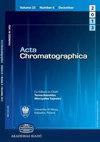Determination of monocrotaline and usaramine in rat plasma by UPLC-MS/MS and their pharmacokinetics
IF 1.7
4区 化学
Q3 CHEMISTRY, ANALYTICAL
引用次数: 0
Abstract
Abstract An ultra-performance liquid chromatography-tandem mass spectrometry (UPLC-MS/MS) method was developed for the determination of monocrotaline and usaramine in rat plasma, to study the plasma drug concentration and pharmacokinetics, and to calculate the absolute bioavailability. The plasma was treated with acetonitrile and methanol (9:1, v/v) protein precipitation method. The chromatographic column was UPLC HSS T3 (50 mm × 2.1 mm, 1.7 μm), the mobile phase was methanol-water (containing 0.1% formic acid with 10 mM ammonium acetate in water), and the elution time was 4 min at a flow rate of 0.4 mL min −1 . Electrospray ionization (ESI) positive ion mode was used for detection and multiple reaction monitoring (MRM) mode was used for quantitative analysis. Monocrotaline and usaramine were administered sublingual intravenously (iv) 1 mg kg −1 and orally (po) 5 mg kg −1 , respectively, with 6 rats in each group, for a total of 24 rats. Then the pharmacokinetic differences in rats were evaluated. For the UPLC-MS/MS method, the calibration curve showed good linearity in the range of 2–2,000 ng mL −1 , where r was greater than 0.99. The precision, accuracy, recovery, matrix effect and stability results were all consistent with the requirements of biological sample detection methods. to provide scientific experimental basis for the basic research The bioavailability of monocrotaline and usaramine in rat plasma was calculated, which was 43.5 and 19.5%, respectively.超高效液相色谱-质谱联用法测定大鼠血浆中苦参碱和乌苏胺的含量及其药动学
摘要建立了超高效液相色谱-串联质谱法(UPLC-MS/MS)测定大鼠血浆中苦参碱和乌萨拉明的方法,研究其血药浓度和药代动力学,并计算绝对生物利用度。血浆用乙腈-甲醇(9:1,v/v)蛋白沉淀法处理。色谱柱为UPLC HSS T3 (50 mm × 2.1 mm, 1.7 μm),流动相为甲醇-水(含0.1%甲酸和10 mm乙酸铵),洗脱时间为4 min,流速为0.4 mL min−1。采用电喷雾电离(ESI)正离子模式进行检测,多反应监测(MRM)模式进行定量分析。分别舌下静脉注射(iv) 1 mg kg - 1和口服(po) 5 mg kg - 1,每组6只大鼠,共24只大鼠。然后评价其在大鼠体内的药动学差异。UPLC-MS/MS方法在2 ~ 2000 ng mL−1范围内线性良好,其中r > 0.99;精密度、准确度、回收率、基质效应和稳定性结果均符合生物样品检测方法的要求。为基础研究提供科学的实验依据。计算了大鼠血浆中苦杏仁碱和乌苏胺的生物利用度,分别为43.5%和19.5%。
本文章由计算机程序翻译,如有差异,请以英文原文为准。
求助全文
约1分钟内获得全文
求助全文
来源期刊

Acta Chromatographica
化学-分析化学
CiteScore
4.00
自引率
0.00%
发文量
55
审稿时长
2.3 months
期刊介绍:
Acta Chromatographica
Open Access
Acta Chromatographica publishes peer-reviewed scientific articles on every field of chromatography, including theory of chromatography; progress in synthesis and characterization of new stationary phases; chromatography of organic, inorganic and complex compounds; enantioseparation and chromatography of chiral compounds; applications of chromatography in biology, pharmacy, medicine, and food analysis; environmental applications of chromatography; analytical and physico-chemical aspects of sample preparation for chromatography; hyphenated and combined techniques; chemometrics and its applications in separation science.
 求助内容:
求助内容: 应助结果提醒方式:
应助结果提醒方式:


